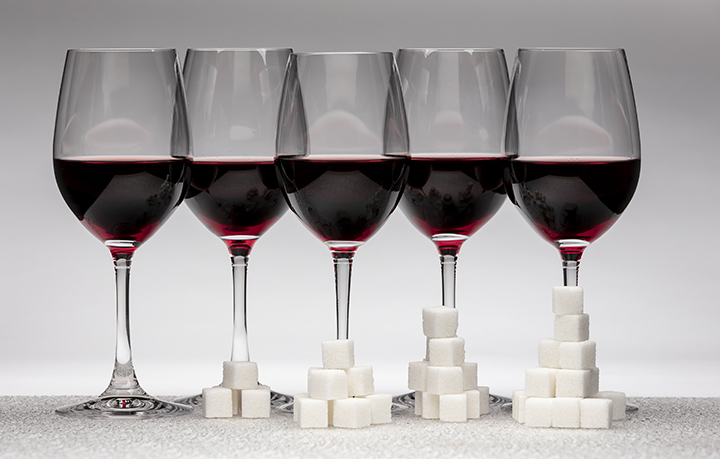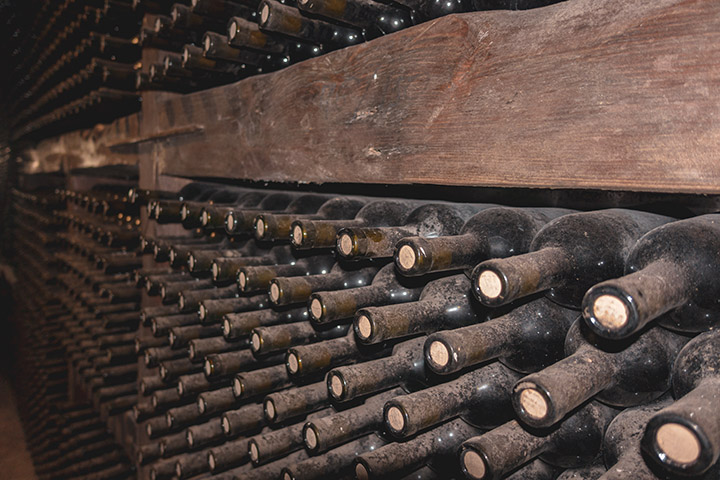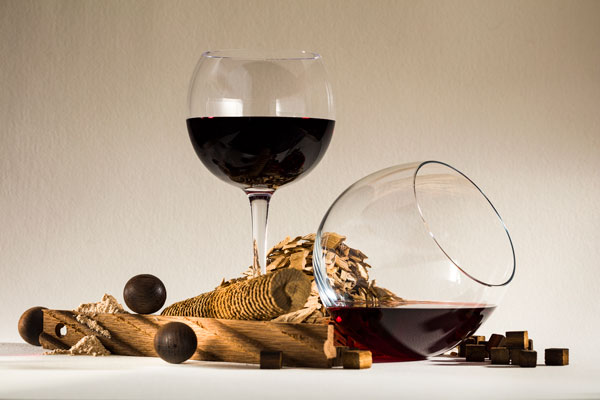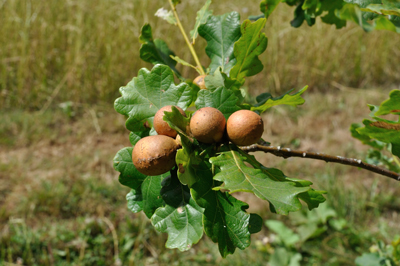Negative Impacts of Oxygen
Positive effects of oxidation? How can that be? Winemakers know that oxygen negatively affects wine and they process wine with the utmost care to prevent oxidation.
Two common winemaking practices that have a positive influence are macroaeration and microoxygenation. Both are used in making some of the best reds and whites, evidenced by the rows and stacks of oak barrels in commercial wineries.
Macroaeration refers to the practice of aerating, or oxygenating, fermenting wine by vigorous racking to produce a softer, less astringent wine that exhibits more fruit character and improved color stability.
Microoxygenation refers to the controlled process of oak-barrel aging where wine is allowed to interact very slowly with a miniscule amount of air penetrating through the barrel. Apart from the flavors and tannins imparted by the wood, wines aged in oak barrels will exhibit more complexity than wines aged in stainless tanks or glass containers primarily because of microoxygenation.
Oxidation reviewed
Simply stated, oxidation is the result of wine being exposed to air during winemaking, at any time from grape or juice handling to bottling. Oxidation can also result from a winemaker’s administration of an inadequate sulfiting regimen. The more technical explanation is that free oxygen in air causes an enzymatic reaction with oxidases — the oxidizable enzymes, such as tyrosinase (poly-phenoloxidase) —found in grape juice resulting in the oxidation of the aromatic and pigmentation compounds.Macroaeration
Macroaeration is only used in red winemaking as it involves vigorous splashing of wine during pump-over or racking operations. Macroaeration has a softening effect on the astringent tannins and enables the winemaker to produce a softer wine. Wine aerated in this way is approachable much earlier (younger) and has well stabilized color. The high phenolic content and relatively low pH protect the wine from negative oxidation effects. In contrast, white wines have a very low tannin content and typically a higher pH, which makes them more prone to the negative effects of oxidation. Macroaeration therefore is never practiced and not recommended for white winemaking. Macroaeration can also benefit red winemaking by providing yeast cells with oxygen and ensuring a healthy fermentation. Yeast require oxygen in order to thrive and to convert sugar into alcohol. Such yeasts are said to be aerobic, or living in the presence of oxygen. If oxygen is not sufficiently available, yeasts can become inhibited and a stuck fermentation can result. Another benefit is reduced hydrogen sulfide (H2S) production. A common cause of H2S in wines, detected as a rotten-egg smell, is vinification from grapes that have been over-treated with sulfur-based vineyard mildew and fungus inhibitors. Red wines made from grapes are more prone to H2S problems because the juice is allowed to macerate with the grape skins (therefore diluting sulfite into the juice). In white wines from grapes, it is not a problem because the juice is not macerated with the skins. Abundantly aerating the wine by racking it against the wall of the container will reduce the amount of potentially harmful H2S. If not treated early, H2S will react in the wine to form first into mercaptans followed by disulfides — both are foul-smelling compounds that cause wine to spoil. The presence of either compound is practically irreversible in home winemaking and the most common result is a lot of spoiled wine being poured down a drain.Macroaerating wine
There are several ways to macroaerate wine, each having a varying degree of effectiveness. These fall into two main categories: splashing wine and injecting oxygen into wine. The most common method of splashing used by home winemakers is quite simple — just let the wine splash against the wall of a carboy during racking. Commercial wineries often use delestage fermentation, also known as the rack-and-return method. This method involves fermenting wine that is racked by gravity and flows into a vat, then returned to the tank with a pump. Although these techniques are proven, some industry experts argue that the wine is still too protected by the layer of carbon dioxide gas that is forming over the wine volume during racking, and therefore the wine does not absorb sufficient air to benefit from macroaeration. It is winemakers of this opinion that turn to the method of injecting oxygen into the wine. Commercial wineries connect a venturi attachment to their hose when returning wine to the top of the tank during the pump-over operation. The venturi attachment is a simple inverted T-connector that allows air to be drawn into the wine stream when the wine is being pumped over. A check valve may also be used to prevent backflow. A home winemaker can easily make a T-connector using polyethylene tubing and plastic barb adapters. The T-connector can then be inserted into the racking line by cutting the tube midway and connecting each end to the barb adapter. You will need to test with various lengths of tube on the leg side of the T until the “burping” stops during racking. Alternatively, if you use a pump with a valve on the suction side for pump-over, be sure to open this valve when working the pump. And remember — do not aerate wine during malolactic fermentation (MLF). ML bacteria are usually very sensitive to oxygen and can become inhibited, which will commonly result in a stuck MLF.Microoxygenation
A miniscule, controlled amount of oxygen during wine aging can be beneficial for wine to develop and show its full potential. It allows wine to develop and age gracefully while softening tannins, stabilizing phenols and increasing flavors complexity — a phenomenon known as microoxidation, or microoxygenation. This cannot happen in air-tight, inert containers such as stainless steel tanks or glass carboys. Until recently, microoxygenation mainly occurred during barrel and bottle aging where wine breathes through the wood and head and stave joints (the tight space between the pieces of wood forming the heads and walls of a barrel). Wine can also breathe through the cork during the aging process. New advances in winemaking technology however, now make it possible to microoxygenate wine in controlled fashion at any stage of the process, such as tank aging, for example, and replicate the benefits of barrel-aged wines, albeit in a much shorter time period. Note: Results are not conclusive as to whether wine should be microoxygenated before or after MLF, and therefore that decision remains in the hands of the winemaker.Microoxygenating wine
In commercial wineries, microoxygenation can be achieved by injecting a continuous, miniscule supply of compressed, industrial-grade oxygen gas using a stainless steel, microsize diffuser installed inside at the bottom of the tank. The amount of oxygen injected is controlled via an automated control box. StaVin, a provider of barrel alternative solutions, has developed an apparatus like this called the “OxBox,” which is based on research by Dr. Jeff McCord (the Director of Research at StaVin). For more information visit www.stavin.com. No such microoxygenation equipment is yet available to home winemakers, but if you are a resourceful and handy person, you could find a gas diffuser and assemble it to an oxygen tank using polyethylene tubing. Be sure to use a regulator on the oxygen tank. Doing this will enable you to run some tests by injecting gas into wine samples in varying amounts and rates. These tests will help you determine what methods yield the best results (since there is no control box). When barrel-aging wine, no special microoxygenation equipment or process is required; the barrel does all the work. The winemaker only has two tasks: The first is to check the wine level every three to four weeks to ensure that everything is developing as planned according to your desired taste. The only other thing you will need to do is top up the barrel. This will avoid “bad” oxidation, offensive smell and unfavorable tastes in your wine. For bottle-aging wine, natural or agglomerated corks are recommended. There is much debate about screw caps and synthetic corks because they do not have the long track record of natural corks. Some winemakers maintain that screw caps and synthetic corks provide too much of an airtight seal depriving the wine of the microoxygen that is necessary for it to evolve gracefully. The argument is that airtight seals inhibit microoxygenation and completely stifle the type of evolution required in well-aged wines. If a winemaker prefers to drink young wine, screw caps or synthetic cork closures are certainly a convenient method.Keeping oxidation in check
A final reminder about the negative effects of oxidation . . . Oxidized wine becomes devoid of subtle and fruity aromas, which makes it seem tired, having lost its finesse and intensity. The result is almost always a wine that takes on a brownish color. As oxidation progresses, the wine will take on a deeper brown color with a sherry-like smell and eventually spoil if untreated. When spoiled, the wine will develop a heavy, white film on the surface. There is also the possibility of a bluish green mold — this is enough to scare most home winemakers upon first sight. However, it is a fairly common occurrence, even with some of the more experienced home winemakers (in spite of advances in home winemaking technology and equipment). If done correctly, home winemakers can develop a means of letting oxygen work for them as opposed to against them and their wines. Those who prefer the qualities of barrel aging can appreciate the positive effects a little oxygen can have on the maturing of their wines. However, not all forms of oxidation are preferable or beneficial, and can cause spoilage. Remember these 10 important tips on preventing negative oxidation and your wine will be appreciative!10 Tips to Prevent Negative Oxidation
- Transfer whites quickly to carboys
- Adjust the pH to a level less prone to oxidation
- Use sulfite as required based on the wine’s pH level
- Top up carboys, barrels and tanks
- Rack by gravity whenever possible
- Avoid pumps
- Use closed systems for transferring wines
- Use ascorbic acid diligently
- Store wine at a cool temperature
- Inspect your equipment regularly




